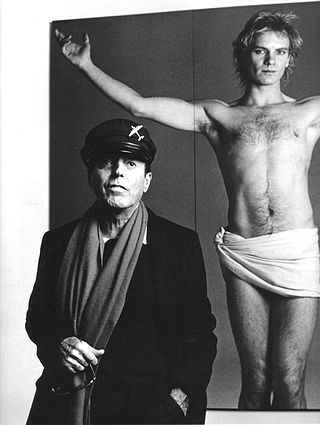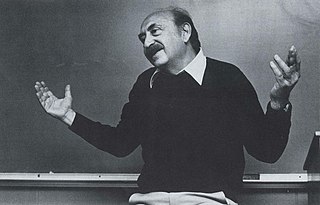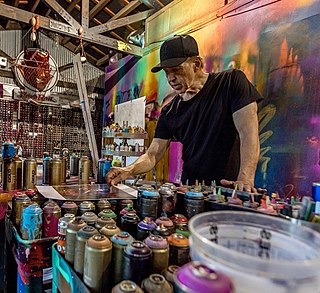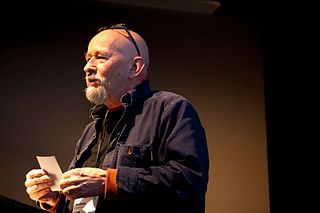
Francesco Scavullo was an American fashion photographer best known for his work on the covers of Cosmopolitan and his celebrity portraits.
Susan "Suzy" Elizabeth Rice is a screenwriter, author of fiction, painter and designer. Rice is noted as the designer of the logo for the series of Star Wars films, as well as many other film logo designs for print advertising and some filmed applications.

Saul Bass was an American graphic designer and Oscar-winning filmmaker, best known for his design of motion-picture title sequences, film posters, and corporate logos.

Toulouse Street is the second studio album by American rock band the Doobie Brothers. It was released in July 1972, by Warner Bros. Records. It was the band's first album with bassist Tiran Porter and also the first with drummer Michael Hossack to augment existing drummer John Hartman, putting in place their trademark twin-drummer sound. Toulouse Street is the name of a street in the French Quarter of New Orleans. The cover and inside centerfold photos were taken at a former brothel on Toulouse Street.

The Captain and Me is the third studio album by American rock band The Doobie Brothers. The album was released on March 2, 1973, by Warner Bros. Records. It features some of their most popular hits including "Long Train Runnin'", "China Grove" and "Without You". The album is certified 2× Platinum by the RIAA.

Stampede is the fifth studio album by American rock band the Doobie Brothers. The album was released on April 25, 1975, by Warner Bros. Records. It was the final album by the band before Michael McDonald replaced Tom Johnston as lead vocalist and primary songwriter. The album has been certified gold by the RIAA.
George Platt Lynes was an American fashion and commercial photographer who worked in the 1930s and 1940s. He produced photographs featuring many gay artists and writers from the 1940s that were acquired by the Kinsey Institute after his death in 1955.

"Think different" is an advertising slogan used from 1997 to 2002 by Apple Computer, Inc., now named Apple Inc. The campaign was created by the Los Angeles office of advertising agency TBWA\Chiat\Day. The slogan has been widely taken as a response to the IBM slogan "Think". It was used in a television advertisement, several print advertisements, and several TV promos for Apple products.

Esprit Holdings Limited is a global publicly traded retail company incorporated in Bermuda, with headquarters in North Point, Hong Kong, and further major locations in Ratingen, Germany; Amsterdam, Netherlands; and New York City. The company offers an assortment of clothing, accessories, footwear, jewelry, and housewares under the Esprit label.
David Kahne is an American record producer, musician, composer, and former record company executive.
John Kosh, known simply as Kosh, is an English art director, album cover designer, graphic artist, and documentary producer/director. He was born in London, England and rose to prominence in the mid-1960s while designing for the Royal Ballet and the Royal Opera House. He was the creative director of Apple Corps for The Beatles and was art director and album cover designer for Abbey Road and Let It Be, as well as other Apple artists.
William Gold was an American graphic designer best known for thousands of film poster designs. During his 70-year career, Gold worked with some of Hollywood's greatest filmmakers, including Laurence Olivier, Clint Eastwood, Alfred Hitchcock, Stanley Kubrick, Elia Kazan, and Ridley Scott. His first poster was for Yankee Doodle Dandy (1942), and his final work was for J. Edgar (2011). Among Gold's most famous posters are those for Casablanca, The Exorcist and The Sting.
John Pasche is a British graphic designer and art director. A Brighton College of Art graduate with an MA from the Royal College of Art, Pasche is best known for being the designer of the tongue and lips logo for The Rolling Stones. Aside from their logo, he has also worked with The Rolling Stones on some of their tour posters and other promotional material throughout the early to mid 1970s.
Glen Wexler is an American photographer who is best known for his elaborately staged digital photocompositions of improbable situations.

Ken Marcus is a famous American photographer, best known for his work in glamour and erotic photography with Penthouse and Playboy magazines and for his own website. For over 40 years he has produced hundreds of centerfolds, editorials, album covers, and advertisements. For many years, Marcus has lectured and conducted professional workshops in the US and internationally.

Jim Evans, sometimes known as T.A.Z., is an American painter, printmaker, and creative director who was a contributing figure in the visual art movement known as underground comix. After a successful career as a comic illustrator, Evans worked as a painter, poster maker, and owner of the digital design group Division 13.

Jim Parkinson is an American type designer in Oakland, California.
George Holz was born in Oak Ridge, Tennessee, graduated from the Art Center College of Design in Pasadena, California, and assisted for Helmut Newton, whom he credits with guiding his career. As a fledgling photographer, he lived in Milan and Paris, where he shot beauty and fashion for major European magazines such as Italian Vogue and French Elle. Afterward, he moved to New York City, where he set up his famous studio on Lafayette Street, traveling frequently to Los Angeles and Europe to shoot fashion, advertising, and portraiture for major publications such as Vanity Fair and Harper's Bazaar. His fine-art nudes have been exhibited in galleries and museums around the world. His shows have included “Original Sin” and “Three Boys from Pasadena – A Tribute to Helmut Newton” with fellow Art Center alumni Just Loomis and Mark Arbeit. Holz has collected a variety of prestigious industry awards over the years including a Grammy and a Clio.
Edward Lee Thrasher Jr., known as Ed Thrasher, was an American art director and photographer. He was the recipient of a number of Grammy Award nominations for his work on album covers and won a Grammy for Best Album Package in 1974 for the Mason Proffit cover Come & Gone. He worked with various recording artists.

Louis Danziger is an American graphic designer and design educator. He is most strongly associated with the late modern movement in graphic design, and with a community of designers from various disciplines working in Southern California in the mid-twentieth century. He is noted for his iconoclastic approach to design, and for introducing the principles of European constructivism to the American advertising vernacular.












